#hupehsuchia
Text

Hupehsuchians were small marine reptiles closely related to ichthyosaurs, known only from the Early Triassic of southwestern China about 249-247 million years ago. They had toothless snouts, streamlined bodies, paddle-like limbs, and long flattened tails, along with a unique pattern of armor along their backs made up of overlapping layers of bony osteoderms.
Hupehsuchus nanchangensis was a mid-sized member of the group, about 1m long (3'3"). Newly-discovered fossils of its skull show that its long flattened snout had a distinctive gap between the bones (similar to the platypus-like snout seen in its relative Eretmorhipis) with an overall shape surprisingly convergent with that of modern baleen whales – suggesting that this hupehsuchian may have been a similar sort of filter-feeder.

Hupehsuchus skull compared to a modern minke whale
[From fig 2 & fig 3 of Fang et al (2023). First filter feeding in the Early Triassic: cranial morphological convergence between Hupehsuchus and baleen whales. BMC Ecol Evo 23, 36. https://doi.org/10.1186/s12862-023-02143-9]
Grooves in the bones along the outer edges of its upper jaws may be evidence of filtering structures similar to baleen, although with no soft-tissue preservation we don't know exactly what this would have looked like. Its slender flexible lower jaws probably also supported a large expandable throat pouch, allowing it to filter plankton out of larger volumes of water.
———
NixIllustration.com | Tumblr | Patreon
#science illustration#paleontology#paleoart#palaeoblr#hupehsuchus#hupehsuchia#ichthyosauromorpha#reptile#marine reptile#art#triassic weirdos
595 notes
·
View notes
Link
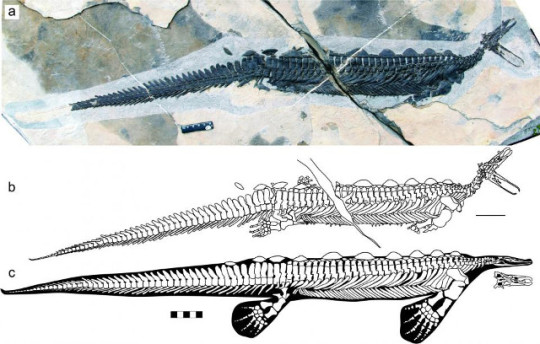

An article published in the journal "Scientific Reports" reports the discovery of two new specimens of Eretmorhipis carrolldongi, a marine reptile that lived about 250 million years ago, in the Early Triassic period, in today's China. A team of researchers studied these new specimens with particular interest because of the previous ones one had its skull but it was in a poor state of conservation and the other one had no skull. The new specimens show that this reptile had similarities with modern platypuses, with a sort of bill of cartilage and receptors that allowed it to hunt based on touch.
0 notes
Text
Hupehsuchus nanchangensis

By Scott Reid
Etymology: Hubei crocodile
First Described By: Young & Dong, 1972
Classification: Biota, Archaea, Proteoarchaeota, Asgardarchaeota, Eukaryota, Neokaryota, Scotokaryota Opimoda, Podiata, Amorphea, Obazoa, Opisthokonta, Holozoa, Filozoa, Choanozoa, Animalia, Eumetazoa, Parahoxozoa, Bilateria, Nephrozoa, Deuterostomia, Chordata, Olfactores, Vertebrata, Craniata, Gnathostomata, Eugnathostomata, Osteichthyes, Sarcopterygii, Rhipidistia, Tetrapodomorpha, Eotetrapodiformes, Elpistostegalia, Stegocephalia, Tetrapoda, Reptiliomorpha, Amniota, Sauropsida, Eureptilia, Romeriida, Disapsida, Neodiapsida, Ichthyosauromorpha, Hupehsuchia, Hupehsuchidae
Referred Species: H. nanchangensis
Status: Extinct
Time and Place: Between 248 to 247 million years ago, in the Olenekian of the Early Triassic

Hupehsuchus is known only from the Jialingjiang Formation in the Hubei Province of China.
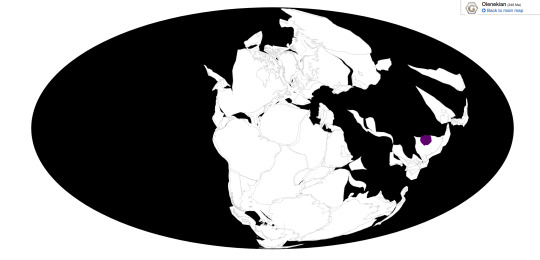
Physical Description: At first glance, Hupehsuchus looks a lot like what you’d expect a primitive ichthyosaur to look like, and indeed they are related. Only around 1-2 metres (3-6 feet) long, its body is long and streamlined, with a long, pointed snout lacking teeth, limbs evolved into large rounded paddles, and a long flattened tail without a fluke. However, on closer inspection Hupehsuchus turns out to be much more bizarre.
Like other hupehsuchians, Hupehsuchus is heavily armoured with vertically layered rows of osteoderms running down its back over the vertebrae (you read that right, they’re on top of each other). These osteoderms interlock with each other, which may have stiffened the body and/or provided ballast. The vertebrae themselves have tall neural spines, giving Hupehsuchus an almost humpbacked appearance, and the neural spines appear to be made up of two separate pieces, one attached to the vertebra, the other seemingly attached to the osteoderms. Only hupehsuchians have vertebrae like that. Its body was probably compressed from side to side, taller than it was wide, and was only flexible around the hips and tail. The armour on its back is complemented by a robust, thick ribs that almost create a shield around its sides, and it even has heavily built, interlocking gastralia on its underside complete with another row of smaller osteoderms on the underside.
The skull of Hupehsuchus is also very unusual. The jaws are long, pointed, and the skull was seemingly quite broad and flat from above, resembling a duck’s bill. The lower jaws were incredibly thin and loosely attached to each other, and were probably capable of bending and bowing outwards like a pelican or baleen whale. The lower jaw may even have supported a large gular pouch, and large hyoid bones imply it had a powerful tongue. Furthermore, several parallel grooves in the upper jaw suggest the presence of a baleen-like structure in its mouth, making it even more uncannily similar to baleen whales. The neck, though, is relatively long and slender compared to a whale.
Diet: The bizarre adaptations of Hupehsuchus suggest it may have been a filter-feeder, sifting small particles and animals out of the water column or near the sea bed.
Behavior: Hupehsuchus was likely a lunge-feeder, in spite of its relatively long neck. The laterally compressed body and flexible hips and tail indicate that it swam by undulating through the water, likely lunging forwards suddenly through swarms of plankton and other small organisms to feed. The flexible jaws of Hupehsuchus imply that it engulfed large amounts of water as it fed, like whales, and would have strained it out through its filtering structures using its tongue.
Hupehsuchus almost certainly gave birth to live young, like ichthyosaurs. Partly because its anatomy was totally unsuited for crawling onto land to lay eggs, but also because one of the oldest ichthyosaurs, Chaohusaurus, is known to have given birth to its babies head-first, the opposite of the tail-first birth in other ichthyosaurs. Babies born head-first in water are at risk of drowning during birth, so this implies that live birth evolved in the ancestors of ichthyosaurs while they were still on land, which would mean that Hupehsuchus likely would have inherited this trait too.
Ecosystem: Hupehsuchus, and indeed all other hupehsuchians for that matter, are known only from a single locality in China. Here Hupehsuchus coexisted with its fellow hupehsuchians Nanchangosaurus, little short-necked Eohupehsuchus, the tubular Parahupehsuchus (I’m sensing a pattern here) and the truly bizarre platypus-faced Eretmorhipis (along with an undescribed polydactylous species!).
The diversity of hupehsuchians in this one habitat likely lead to diverse niche partitioning between them. Hupehsuchus was one of the largest, and seemingly occupied a more active lifestyle, lunge-feeding on organisms in the water. Nanchangosaurus had a similar skull to Hupehsuchus, and so may have had a similar diet, but it was smaller and had a body shape more suited for swimming along the sea bed. Parahupehsuchus was so heavily encased in armour that its body was practically a bony tube, and rather than round paddles it had pointed flippers, suggesting a different swimming style (for what, we don’t know). The bizarrest of them all, Eretmorhipis, may have specialised in grubbing blindly through the seabed, sensing prey with its bill like a platypus, possibly even at night.
The habitat is believed to have been a shallow lagoonal environment, perhaps sheltered from larger predators that could have preyed upon them, like giant nothosaurs. However, they nonetheless coexisted with the primitive ichthyosaur Chaohusaurus and two species of pachypleurosaur (sauropterygians related to nothosaurids), Keichousaurus and Hanosaurus, as well as an undescribed large sauropterygian 3-4 metres (10-13 feet) long. Strangely, no fish have been discovered in this formation, so it’s quite possible that the smaller hupehsuchians were the main food source for some of these larger marine reptiles (as evidenced by a bite taken out of one Eohupehsuchus paddle!). These conditions may have also prompted the strange dietary adaptations of the hupehsuchians, with no smaller fishes to eat, they specialised in eating tiny marine invertebrates and other plankton.
Other: Hupehsuchians are very mysterious marine reptiles, they are known from only one location in the whole world and from a very narrow range of time in the earliest Triassic. Hupehsuchus was once suggested to be a missing link between the ichthyosaurs and their as-yet-unknown terrestrial ancestors, although as more early ichthyosauromorphs have been discovered it is clear that is not the case, and that hupehsuchians are a bizarre offshoot of their own.
Hupehsuchus is part of a surprisingly diverse range of early-derived ichthyosauromorphs that lived in China during the Early Triassic, just a few million years after the Permian Mass Extinction, including the first proper ichthyopterygians and the peculiar (possibly amphibious) nasorostrans like Cartorhynchus. These marine reptiles were very quick to diversify in the wake after the extinction, as the strange filter-feeding lifestyle of Hupehsuchus testifies, quite the opposite of the predicted slow recovery for marine ecosystems. However, it remains a mystery why only the ichthyosaurs prevailed, and all the other strange and diverse ichthyosauromorphs like Hupehsuchus never even made it into the Middle Triassic. Perhaps they were just too strange and specialised even for the Triassic.
~ By Scott Reid
Sources under the Cut
Carrol, Robert L.; Dong, Z.-M. (1991). "Hupehsuchus, an enigmatic aquatic reptile from the Triassic of China, and the problem of establishing relationships". Philosophical Transactions: Biological Sciences. 331 (1260): 131–153.
Chen, X. H.; Motani, R.; Cheng, L.; Jiang, D. Y.; Rieppel, O. (2014). "A Carapace-Like Bony 'Body Tube' in an Early Triassic Marine Reptile and the Onset of Marine Tetrapod Predation". PLoS ONE. 9 (4): e94396.
Chen X. H., Motani, R., Cheng, L., Jiang, D. Y., Rieppel, O. (2014) “The Enigmatic Marine Reptile Nanchangosaurus from the Lower Triassic of Hubei, China and the Phylogenetic Affinities of Hupehsuchia”. PLoS ONE 9(7): e102361.
Chen, Xiao-hong; Motani, Ryosuke; Cheng, Long; Jiang, Da-yong; Rieppel, Olivier (May 27, 2015). "A New Specimen of Carroll's Mystery Hupehsuchian from the Lower Triassic of China". PLoS ONE. 10 (5): e0126024.
Cheng, L., Motani, R., Jiang, D.Y., Yan, C.B., Tintori, A. and Rieppel, O., (2019). “Early Triassic marine reptile representing the oldest record of unusually small eyes in reptiles indicating non-visual prey detection”. Scientific reports, 9(1), p.152.
Motani, R., Chen, X. H., Jiang, D. Y., Cheng, L., Tintori, A., Rieppel, O. (2015). “Lunge feeding in early marine reptiles and fast evolution of marine tetrapod feeding guilds”. Scientific reports. 5: 8900.
Wu, X.-C.; Li, Z.; Zhou, B.-C.; Dong, Z.-M. (2003). "A polydactylous amniote from the Triassic period". Nature. 426 (6966): 516.
Xiao-hong Chen; Ryosuke Motani; Long Cheng; Da-yong Jiang & Olivier Rieppel (2014). "A Small Short-Necked Hupehsuchian from the Lower Triassic of Hubei Province, China". PLoS ONE. 9 (12): e115244.
Xiao-hong Chen; Ryosuke Motani; Long Cheng; Da-yong Jiang; Olivier Rieppel (May 27, 2015). "A New Specimen of Carroll's Mystery Hupehsuchian from the Lower Triassic of China". PLoS ONE. 10 (5): e0126024.
#Hupehsuchus nanchangensis#Hupehsuchus#Triassic#Ichthyosaur#Reptile#Marine Reptile#Prehistoric Life#Palaeoblr#Paleontology#Prehistory#Triassic Madness#Triassic March Madness
551 notes
·
View notes
Text
Hupehsuchus nanchangensis

Art by: Smokeybjb, CC BY-SA 3.0
Name: Hupehsuchus nanchangensis
Name Meaning: Hubei crocodile (Hubei Province in China)
First Described: 1972
Described By: Young and Dong
Classification: Chordata, Tetrapoda, Reptilia, Hupehsuchia, Hupehsuchidae
Remember my post on Eretmorhipis, the weird and strange guy from the Early Triassic who was a part of a clade of marine reptiles that were closely related to ichthyosaurs? Well, we have another member of that clade for today’s entry! Hupehsuchus was also from the Early Triassic and was discovered in China and they too were pretty strange in their own right. They had a long toothless snout, long tail, and their limbs were like paddles, but not fully formed flippers as seen in later ichthyosaurs. Oh and let’s not forget, Hupehsuchus had armor on its back as well. There’s still a debate within the paleontological community on whether Hupehsuchus was even closely related to the ichthyosaurs or not. Some hypothesize that because this guy had extra bones within its hands instead of within its individual fingers, that the difference itself may possibly rule Hupehsuchus out in close relation to ichthyosaurs.
https://en.wikipedia.org/wiki/Hupehsuchia
https://en.wikipedia.org/wiki/Hupehsuchus
#Hupehsuchus#palaeoblr#paleontology#palaeontology#prehistoric#Mesozoic#ancient marine reptiles#Not a dinosaur#ichthyopterygia
27 notes
·
View notes
Link
My, what tiny eyes you had, Eretmorhipis carrolldongi.
Two newly found specimens of the mysterious, platypus-like reptile suggest that the ancient creature had very small eyes for its size, and may have hunted mainly by touch. That makes E. carrolldongi the oldest known amniote — a group that includes reptiles and mammals — to use a sense other than sight to find its prey, scientists report online January 24 in Scientific Reports.
E. carrolldongi, which lived about 250 million years ago, is one of numerous strange creatures dating to the Early Triassic described by scientists in recent years. It is part of an oddball array of marine reptiles called Hupehsuchia that lived in a vast lagoon spanning hundreds of kilometers across what’s now southern China. That flourishing of forms, which came on the heels of the mass extinction at the end of the Permian Period 252 million years ago, suggests that marine reptiles diversified millions of years earlier than once thought, the researchers say.
E. carrolldongi was named in part for its large, fan-shaped flippers, which give its body a passing resemblance to a platypus (Eretmorhipis means “oar fan”). Now, the newly discovered specimens, the first with skulls, point to one more thing that the ancient swimmer had in common with the modern platypus: very small eyes.
The creature also had a small head, meaning that it probably didn’t use hearing to forage, given the challenge of localizing sound in water. Chemoreception — used by snakes, for example, to gather information from the atmosphere through their tongues — is also unlikely based on the lack of certain telltale holes the skull, say paleontologist Long Cheng of the Wuhan Centre of China Geological Survey and colleagues.
By elimination, the researchers suggest that E. carrolldongi probably used tactile cues, such as hair cells that can help an animal detect movement, to stalk its lagoon prey. Still, electroreception, in which predators sense electric fields generated by moving prey, can’t be ruled out, the scientists say. And that would be one more thing it had in common with platypuses — they use electroreception, too.
4 notes
·
View notes
Text
My favorite part
Ichthyosauromorpha (Motani et al., 2015a) is an expansive group that includes the two clades Hupehsuchia (Young & Dong, 1972b) and Ichthyosauriformes. Hupehsuchia is a distinctive clade of Early Triassic marine reptiles so far known only from five southern Chinese species, namely Nanchangosaurus suni (Wang, 1959), Hupehsuchus nanchangensis (Carroll & Dong, 1991), Parahupehsuchus longus (Chen et al., 2014b), Eohupehsuchus brevicollis (Chen et al., 2014c) and Eretmorhipis carrolldongi (Chen et al., 2015).
0 notes
Link
A new specimen of an enigmatic hupehsuchian genus is reported. The genus was first recognized by Robert L. Carroll and Zhi-ming Dong in 1991, who refrained from naming it because of the poor quality of the only specimen known at the time. After more than two decades, we finally report a second specimen of this genus, which remained unprepared until recently. The new specimen preserves most of the skeleton except the skull, allowing us to erect a new genus and species, Eretmorhipis carrolldongi. The new species shares many characters with Parahupehsuchus longus, including the strange axial skeleton that forms a bony body tube. However, the body tube is short in the new species, being limited to the pectoral region. The vertebral count and limb morphology considerably differ between the new species and P. longus. The forelimb of E. carrolldongi is markedly larger than its hind limb as in Hupehsuchus nanchangensis but unlike in P. longus. The new species is unique among hupehsuchians in a list of features. It has manual and pedal digits that spread radially, forming manus and pes that are almost as wide as long. The third-layer elements of the dermal armor are unusually large, spanning four vertebral segments, yet there are substantial gaps among them. With the addition of the unique paddle, it is now clear that Hupehsuchia had diverse forelimb morphologies spanning from paddles to flippers, unlike ichthyopterygians that were taxonomically more diverse yet only had flippers.
1 note
·
View note
Photo
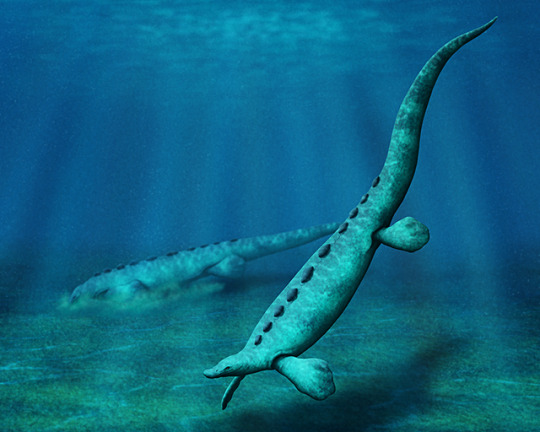
Eretmorhipis carrolldongi, a hupehsuchian marine reptile from the Early Triassic of China (~247 mya).
This species was originally named back in 2015, but at the time the only known specimens were missing their heads. It was assumed that its skull would have looked similar to those of other hupehsuchians... but now new fossils have been found, and it seems to have actually been much much weirder!
Eretmorhipis’ head was surprisingly tiny in proportion to its body -- sort of like a marine version of Cotylorhynchus -- and its shape convergently resembled the modern platypus, with a wide “duck bill” and very small eyes. It may have hunted for food along the seafloor in a similar manner to the platypus, using either a highly sensitive sense of touch or possibly even electroreception to locate small invertebrates like worms and shrimp.
It also had much larger bony osteoderms than its other known hupehsuchian relatives, forming a distinctive protruding spiky ridge down its back. At about 85cm in length (2′9″) it was one of the largest marine animals around at the time, so this structure probably wasn’t needed for defense -- but as with other hupehsuchians its actual function is still unknown.
#science illustration#paleontology#paleoart#palaeoblr#eretmorhipis#hupehsuchia#ichthyosauromorpha#marine reptiles#triassic#it's a hupehsuchian of course it's weird#art#duck bills (woo ooh!)#i love hupehsuchians so much and i hope they keep on surprising us
422 notes
·
View notes
Link

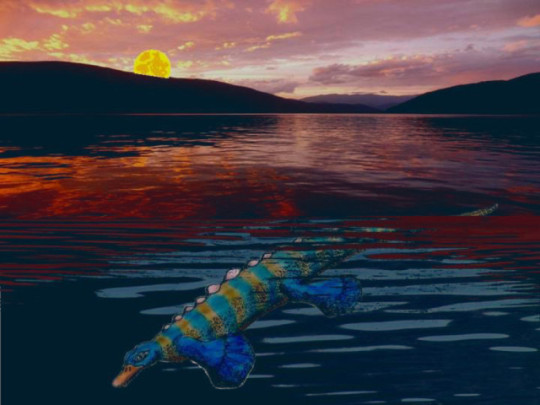
Un articolo pubblicato sulla rivista "Scientific Reports" riporta la scoperta di due nuovi esemplari di Eretmorhipis carrolldongi, un rettile marino che visse circa 250 milioni di anni fa, nel periodo Triassico Inferiore, nell'odierna Cina. Un team di ricercatori ha studiato questi nuovi esemplari con particolare interesse perché dei precedenti uno aveva il cranio ma era in un cattivo stato di conservazione e l'altro era privo di cranio. I nuovi esemplari mostrano che questo rettile aveva similitudini con i moderni ornitorinchi, con una sorta di becco cartilagineo e recettori che gli permettevano di cacciare basandosi sul tatto.
0 notes
Text
Eretmorhipis carrolldongi
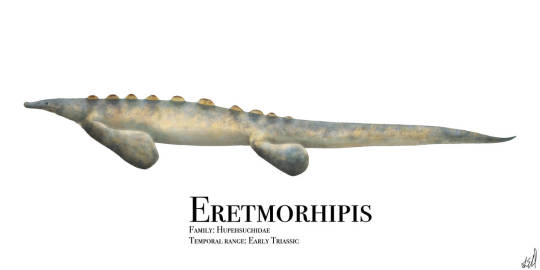
Art by: Liam Elward, https://www.deviantart.com/prehistorybyliam/art/Eretmorhipis-783558933
Name: Eretmorhipis carrolldongi
Name Meaning: Oar fan
First Described: 2015
Described By: Chen et al.,
Classification: Chordata, Tetrapoda, Reptilia, Hupehsuchia, Hupehsuchidae
Eretmorhipis was a weird and very strange marine reptile. It had osteoderms on its back, thick ribs, and its digits were fan shaped. Eretmorhipis is actually a part of Hupehsuchia, which are pretty much reptiles that are close in relation to ichthyosaurs. Anyways, Eretmorhipis existed during the Early Triassic and was found in China’s Jialingjiang Formation. We’ve found specimens in the past that consisted of post-cranial material, but most recently in 2018, paleontologists found a specimen that included the skull and mostly complete post-cranial remains of this odd aquatic creature.
Sources:
https://en.wikipedia.org/wiki/Eretmorhipis
#Eretmorhipis#palaeoblr#paleontology#palaeontology#prehistoric#ancient marine reptiles#Mesozoic#Not a dinosaur#ichthyopterygia
28 notes
·
View notes